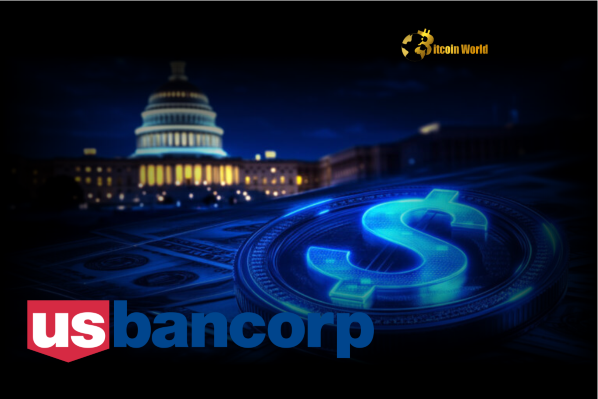BitcoinWorld

U.S. Bancorp Strategically Explores Stablecoin Opportunity for Payments
The world of traditional finance and cryptocurrency continues to converge, and recent statements from a major player signal significant interest. U.S. Bancorp, one of the largest banks in the United States, is actively looking into the potential of stablecoin technology, with a specific eye on revolutionizing payments.
Why U.S. Bancorp is Eyeing Stablecoins for Payments
At the recent Morgan Stanley Financial Conference, U.S. Bancorp CEO Gunjan Kedia shared that the bank is exploring various stablecoin-related business opportunities. The primary focus? Enhancing payments services. This isn’t just casual observation; it’s a strategic exploration into how digital currencies pegged to stable assets (like the U.S. dollar) could offer tangible benefits.
Why are banks like U.S. Bancorp finding stablecoins appealing for payments? Several factors make this technology potentially transformative:
- Speed and Efficiency: Traditional payment systems, especially cross-border ones, can be slow and involve multiple intermediaries. Stablecoins operating on blockchain networks can facilitate near-instantaneous settlements.
- Lower Costs: Reducing intermediaries and streamlining processes can potentially lower transaction fees for both the bank and its customers.
- 24/7 Availability: Unlike traditional banking hours, blockchain networks operate around the clock, allowing for payments anytime, anywhere.
- Programmability: Stablecoins can be integrated into smart contracts, enabling automated payments, escrow services, and other complex financial operations.
This move by a prominent bank like U.S. Bancorp highlights a growing recognition within traditional finance of the potential efficiencies and new business models enabled by blockchain technology and cryptocurrency assets like stablecoins.
Understanding Stablecoins: More Than Just Crypto Volatility
For those less familiar with the cryptocurrency space, it’s important to distinguish stablecoins from more volatile assets like Bitcoin or Ethereum. A stablecoin is designed to maintain a stable value relative to a specific asset or basket of assets, most commonly fiat currencies like the U.S. dollar. This stability is crucial for their use in payments and other financial transactions, where price swings would be detrimental.
There are different types of stablecoins, typically categorized by their collateralization method:
| Type | Description | Examples |
|---|---|---|
| Fiat-Collateralized | Backed 1:1 by traditional currency held in reserve accounts. | USDT, USDC, BUSD |
| Crypto-Collateralized | Backed by other cryptocurrencies, often overcollateralized to absorb price volatility. | DAI |
| Algorithmic | Value is maintained through algorithmic rules that adjust supply and demand. | (Note: This type has faced significant challenges and risks) |
U.S. Bancorp‘s interest likely lies in exploring how regulated, potentially bank-issued or bank-partnered, stablecoins could be integrated into their existing infrastructure for corporate and potentially retail payments.
Challenges and Considerations for a Bank Entering the Stablecoin Space
While the potential benefits are clear, U.S. Bancorp‘s exploration isn’t without its hurdles. Integrating stablecoins into a large, regulated bank involves navigating complex challenges:
- Regulatory Clarity: The regulatory landscape for stablecoins in the U.S. is still evolving. Banks need clear guidelines on issuance, reserves, compliance, and consumer protection.
- Technological Integration: Implementing blockchain technology and stablecoin infrastructure within existing legacy banking systems requires significant technical expertise and investment.
- Security Risks: As with any digital asset, security against hacks, fraud, and operational failures is paramount.
- Competition: The stablecoin market is already populated by established players, though a bank-backed or regulated stablecoin could offer distinct advantages in trust and integration with traditional finance.
- Customer Adoption: Educating customers and ensuring ease of use will be key to successful adoption of stablecoin-based payment services.
U.S. Bancorp‘s cautious approach, focusing on exploration, suggests they are carefully weighing these factors before committing to specific initiatives. Their status as a regulated financial institution could provide a level of trust and compliance that some existing stablecoins lack, potentially positioning them uniquely in the market.
What This Means for the Future of Banking and Cryptocurrency
The fact that a major institution like U.S. Bancorp is publicly discussing its interest in stablecoin opportunities, particularly for payments, is a significant indicator of the ongoing maturation and adoption of cryptocurrency technology within mainstream finance. It suggests that banks are moving beyond simply viewing crypto as an asset class for investment or custody and are actively considering its use in core banking functions like transaction processing.
This could pave the way for:
- More efficient and cheaper payment rails for businesses and potentially consumers.
- New financial products and services built on stablecoin infrastructure.
- Increased institutional adoption and understanding of blockchain technology.
- Potential collaboration between traditional banks and existing stablecoin issuers or blockchain technology providers.
The exploration by U.S. Bancorp is not an isolated event. Many other global banks are also researching or piloting various forms of digital currencies, including central bank digital currencies (CBDCs) and private stablecoins. This collective interest underscores a recognition that digital assets and blockchain technology will play a role in the future of finance.
Actionable Insights for the Reader
What should you take away from U.S. Bancorp‘s interest in stablecoin payments?
- Stay Informed: Keep an eye on how traditional financial institutions like banks engage with cryptocurrency. Their moves can significantly impact the market and regulatory environment.
- Understand Stablecoins: Learn about the different types of stablecoins and their potential uses beyond just trading. Their role in payments and decentralized finance (DeFi) is growing.
- Consider the ‘Why’: Think about the underlying problems banks are trying to solve with stablecoins (e.g., slow payments, high costs). This helps you understand the real-world utility of the technology.
- Watch for Regulation: Regulatory developments will heavily influence how banks can utilize stablecoins. Pay attention to legislative efforts in major financial centers.
U.S. Bancorp‘s exploration is a signal that the integration of cryptocurrency into mainstream financial services is progressing. While full-scale implementation of stablecoin-based payments by a major bank is likely still some time away, the foundational research and strategic interest are clearly present.
Summary: A Major Bank’s Strategic Step into Stablecoins
In conclusion, U.S. Bancorp‘s public acknowledgement of exploring stablecoin opportunities, particularly for payments, is a significant development. It reflects a strategic interest from a major traditional bank in leveraging cryptocurrency technology to potentially improve efficiency, reduce costs, and innovate within its core business functions. While challenges related to regulation, technology, and security remain, the exploration itself is a strong indicator of the direction in which the financial industry is heading, further blurring the lines between traditional finance and the digital asset world.
To learn more about the latest cryptocurrency trends, explore our article on key developments shaping stablecoin institutional adoption.
This post U.S. Bancorp Strategically Explores Stablecoin Opportunity for Payments first appeared on BitcoinWorld and is written by Editorial Team





